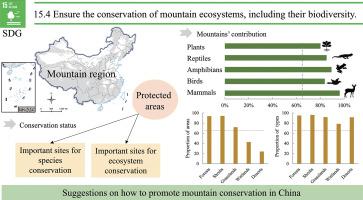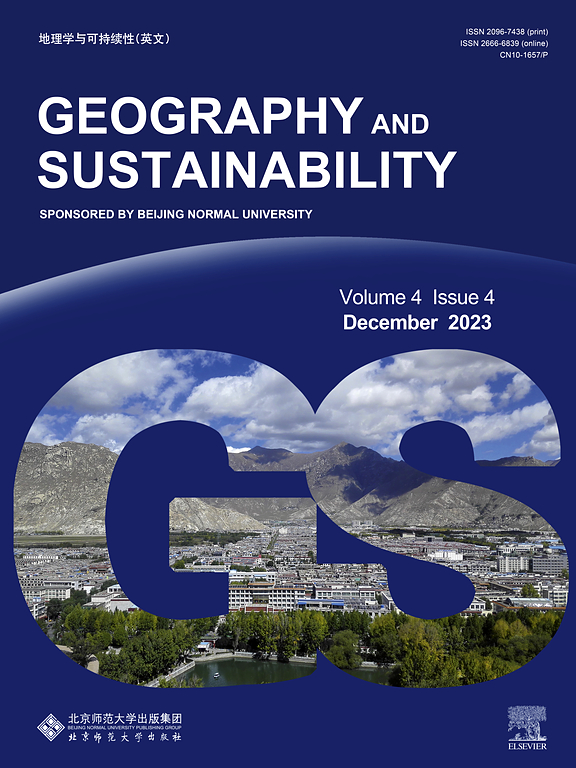China’s mountain biodiversity and conservation status
IF 8
1区 环境科学与生态学
Q1 GEOGRAPHY, PHYSICAL
引用次数: 0
Abstract
As global biodiversity continues to decline and ecosystems degrade, mountains are often regarded as crucial refuges for numerous species due to their unique montane environments and relatively unfragmented landscapes. The conservation of mountain biodiversity is a key component of the United Nations Sustainable Development Agenda. Gaining insight into the distribution of montane species and identifying priority conservation areas are essential for effective action. However, such efforts have been relatively limited in China. In this study, we evaluated the contribution of mountains to biodiversity conservation within the country. Our findings indicate that China’s mountains support a remarkable percentage of the country’s wildlife. They include 95 % of mammal species, 85 % of bird species, 89 % of amphibian species, 85 % of reptile species, and 80 % of higher plant species. These areas harbor over 90 % of China’s natural ecosystem subclasses, despite constituting only 65 % of the total land area. Approximately a quarter of important sites for mountain biodiversity are covered by protected areas, but some key regions remain unprotected. It is recommended that protection be prioritized in the southeastern Qinghai-Xizang Plateau, the Hengduan Mountains and the Southeastern China Hills, with a focus on narrowly distributed ecosystems, to achieve the biodiversity target and vision.

中国山地生物多样性及其保护现状
随着全球生物多样性的持续下降和生态系统的退化,由于其独特的山地环境和相对完整的景观,山区往往被视为许多物种的重要避难所。保护山地生物多样性是联合国可持续发展议程的一个关键组成部分。深入了解山地物种的分布和确定优先保护区对于采取有效行动至关重要。然而,这种努力在中国相对有限。在本研究中,我们评估了山区对国内生物多样性保护的贡献。我们的研究结果表明,中国的山区支撑着该国相当大比例的野生动物。它们包括95%的哺乳动物、85%的鸟类、89%的两栖动物、85%的爬行动物和80%的高等植物。这些地区拥有中国90%以上的自然生态系统亚类,尽管它们只占总陆地面积的65%。大约四分之一的山地生物多样性重要地点被保护区覆盖,但一些关键地区仍然不受保护。建议优先保护青藏高原东南部、横断山脉和东南丘陵,重点保护狭窄分布的生态系统,以实现生物多样性目标和愿景。
本文章由计算机程序翻译,如有差异,请以英文原文为准。
求助全文
约1分钟内获得全文
求助全文
来源期刊

Geography and Sustainability
Social Sciences-Geography, Planning and Development
CiteScore
16.70
自引率
3.10%
发文量
32
审稿时长
41 days
期刊介绍:
Geography and Sustainability serves as a central hub for interdisciplinary research and education aimed at promoting sustainable development from an integrated geography perspective. By bridging natural and human sciences, the journal fosters broader analysis and innovative thinking on global and regional sustainability issues.
Geography and Sustainability welcomes original, high-quality research articles, review articles, short communications, technical comments, perspective articles and editorials on the following themes:
Geographical Processes: Interactions with and between water, soil, atmosphere and the biosphere and their spatio-temporal variations;
Human-Environmental Systems: Interactions between humans and the environment, resilience of socio-ecological systems and vulnerability;
Ecosystem Services and Human Wellbeing: Ecosystem structure, processes, services and their linkages with human wellbeing;
Sustainable Development: Theory, practice and critical challenges in sustainable development.
 求助内容:
求助内容: 应助结果提醒方式:
应助结果提醒方式:


